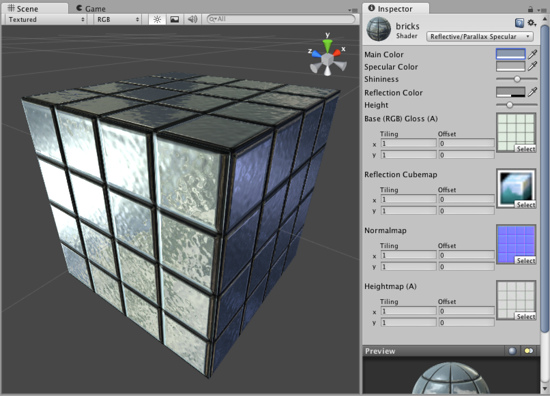Reflective Parallax Specular

One consideration for this shader is that the Base texture's alpha channel will double as both the Reflection Map and the Specular Map.
Reflective Properties
This shader will simulate reflective surfaces such as cars, metal objects etc. It requires an environment Cubemap which will define what exactly is reflected. The main texture's alpha channel defines the strength of reflection on the object's surface. Any scene lights will add illumination on top of what is reflected.
Parallax Normal mapped Properties
Parallax Normal mapped is the same as regular Normal mapped, but with a better simulation of "depth". The extra depth effect is achieved through the use of a Height Map. The Height Map is contained in the alpha channel of the Normal map. In the alpha, black is zero depth and white is full depth. This is most often used in bricks/stones to better display the cracks between them.
The Parallax mapping technique is pretty simple, so it can have artifacts and unusual effects. Specifically, very steep height transitions in the Height Map should be avoided. Adjusting the Height value in the Inspector can also cause the object to become distorted in an odd, unrealistic way. For this reason, it is recommended that you use gradual Height Map transitions or keep the Height slider toward the shallow end.
Specular Properties
Specular computes the same simple (Lambertian) lighting as Diffuse, plus a viewer dependent specular highlight. This is called the Blinn-Phong lighting model. It has a specular highlight that is dependent on surface angle, light angle, and viewing angle. The highlight is actually just a realtime-suitable way to simulate blurred reflection of the light source. The level of blur for the highlight is controlled with the Shininess slider in the Inspector.
Additionally, the alpha channel of the main texture acts as a Specular Map (sometimes called "gloss map"), defining which areas of the object are more reflective than others. Black areas of the alpha will be zero specular reflection, while white areas will be full specular reflection. This is very useful when you want different areas of your object to reflect different levels of specularity. For example, something like rusty metal would use low specularity, while polished metal would use high specularity. Lipstick has higher specularity than skin, and skin has higher specularity than cotton clothes. A well-made Specular Map can make a huge difference in impressing the player.
Performance
Generally, this shader is on the more expensive rendering side. For more details, please view the Shader Peformance page.
Page last updated: 2007-05-08